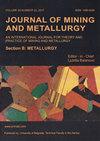采用搅拌摩擦法制备了功能梯度AZ91/WC纳米复合材料
IF 1
4区 材料科学
Q3 METALLURGY & METALLURGICAL ENGINEERING
Journal of Mining and Metallurgy Section B-Metallurgy
Pub Date : 2022-01-01
DOI:10.2298/jmmb220322018s
引用次数: 0
摘要
本文采用一种新型多级缩径法制备了功能梯度AZ91/WC纳米复合材料。将WC纳米颗粒装入直径分级的腔室中,并使用带有四边槽探头的工具进行摩擦搅拌处理。采用不同的刀具转速(830、960和1160 rpm),切削速度和切削深度分别为40 mm/min和0.1 mm,获得了功能梯度纳米复合材料。利用光学显微镜、扫描电镜、能量色散光谱以及硬度、销盘磨损和动电位极化等测试对功能梯度样品和AZ91镁合金的特性进行了评价。结果表明:随着刀具转速的增加,WC纳米颗粒的细化和分级分布增强;随着刀具转速的增加,硬度略有增加。WC纳米颗粒的加入降低了合金的磨损率,提高了合金的耐蚀性。磨料磨损是干滑动过程中材料去除的主要方式,裂纹和凹坑是腐蚀表面的主要特征。本文章由计算机程序翻译,如有差异,请以英文原文为准。
Functionally graded AZ91/WC nanocomposite fabricated via friction stir processing using a novel way
In this work, functionally graded AZ91/WC nanocomposites were produced by a novel multi-stage reduction of chamber diameter method. The WC nanoparticles were packed in chambers having graduated diameters and friction stir processing was applied using tool with four-sided fluted probe. The functionally graded nanocomposites were obtained using different tool rotational speeds (830, 960 and 1160 rpm) with a constant traverse speed and plunge depth of 40 mm/min and 0.1 mm, respectively. The characteristics of the functionally graded samples and AZ91 Mg alloy were evaluated utilizing optical and scanning electron microscopes, and energy dispersive spectroscopy as well as other tests such as hardness, pin on disc wear and potentiodynamic polarization tests. The results showed that ?-Mg refining and graded distribution of WC nanoparticles were enhanced with augmenting tool rotational speed. The hardness increased slightly with augmenting tool rotational speed. The results also revealed that the wear rate was decreased and corrosion resistance was improved by adding WC nanoparticles. Abrasive wear mode was the main mode of material removal during dry sliding while cracks and pits were the main features of corroded surface.
求助全文
通过发布文献求助,成功后即可免费获取论文全文。
去求助
来源期刊
CiteScore
2.00
自引率
40.00%
发文量
19
审稿时长
2 months
期刊介绍:
University of Belgrade, Technical Faculty in Bor, has been publishing the journal called Journal of Mining and Metallurgy since 1965 and in 1997 it was divided in two independent journals dealing with mining and metallurgy separately. Since 2009 Journal of Mining and Metallurgy, Section B: Metallurgy has been accepted in Science Citation Index Expanded.
Journal of Mining and Metallurgy, Section B: Metallurgy presents an international medium for the publication of contributions on original research which reflect the new progresses in theory and practice of metallurgy. The Journal covers the latest research in all aspects of metallurgy including hydrometallurgy, pyrometallurgy, electrometallurgy, transport phenomena, process control, solidification, mechanical working, solid state reactions, materials processing, surface treatment and relationships among processing, structure, and properties of materials.

 求助内容:
求助内容: 应助结果提醒方式:
应助结果提醒方式:


